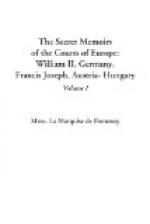[Illustration: IN THE WHITE HALL After a drawing by Oreste Cortazzo]
The “spiel-cour” only takes place on the eve of the wedding of a member of the Hohenzollern family. It is held in the weisse-saal of the Berlin schloss, or palace. The kaiser and the kaiserin, with the bridal pair, seat themselves at a card table under a canopy of gold brocade, adorned with the imperial arms. The other royal personages sit at card-tables lower down on the dais on each side. The invited guests then pass before their majesties, precisely as at the “defiler-cour.”
The “sprech-cour” is, as its name signifies, a kind of conversazione. The persons invited are partitioned off, according to their ranks, in different rooms, through which their majesties promenade. Those not personally known to the emperor and empress are introduced by the masters of ceremonies in attendance, and others with whom their majesties are already acquainted are honored by a short conversation.
“Trauer-cours,” or mourning levees, are held immediately after the death of the reigning sovereign, and are exceedingly impressive, mainly by reason of the flowing robes and peculiar sable-hued attire which the ladies of the royal family of Prussia and of their courts are compelled by tradition and etiquette to adopt. Moreover, all the apartments are draped in black, the gilded ornaments being shrouded in crape. The last of these mourning courts was held by Empress Frederick, in the place of her dying husband, on the demise of old Emperor William, and so painful and depressing was this occasion, that at her urgent request, no ceremony of the kind was held when “Unser Fritz” in his turn, was gathered to his fathers.
Very stately are the court balls, of which a number are given in the early part of each year, between the First of January and the beginning of Lent. In fact, court balls at Berlin are infinitely less amusing, at any rate to young people, than are analogous entertainments at the Hofburg, at Vienna, or at Buckingham Palace, in London. This is due partly to the fact that Hohenzollern tradition and etiquette require that the proceedings should be inaugurated with the Polonaise, and furthermore, because the waltz has, for nearly forty years, been denied a place in the programme of terpsichorean entertainments at court.




